In this article:
Candida albicans, a type of yeast, is a natural part of the human microbiota. It lives on your skin and within your gut without causing any harm. This commensal organism actually helps your body perform certain key functions better.

But overgrowth of this fungus can disrupt the healthy flora, taking the form of a fungal infection. In fact, C. albicans is the most common source of fungal infections in human beings.
It can cause superficial mucosal candidiasis, such as oral thrush and vaginal yeast infections, or enter the bloodstream and travel to different organs in the body such as the kidneys, liver, spleen, lungs, brain, and heart valves, causing infection and even leading to death. People with compromised immunity, such as those with HIV, are at a greater risk of the latter.
Evidence suggests that such infections usually start with fungal overgrowth inside the patient’s gut, which then spreads to various other sites in the body.
The best way to manage these fungal infections and keeping them from turning fatal is by preventing them from occurring in the first place. Diet can play a major role in keeping the yeast population within your mouth and gut in check.
Foods That Fight Yeast Infections
The following are food items with the fungicidal activity that can help you control and prevent fungal overgrowth, some of which might even be effective against fluconazole (antifungal drug)-resistant Candida. (1)
1. Cranberry juice

For any microbe to infect any part of your body, it will first have to find a suitable place to stick itself to. Then, it will replicate, forming a biofilm across the surface, and cause an infection. (2) Biofilm formation has been associated with increased resistance of the fungi against antifungal drugs.
It has been shown that cranberry extracts inhibit the growth of candida species and contain proanthocyanidins that do not allow these pathogens to stick to any surface due to their anti-adhesive nature. (3)
Research suggests that consuming this fruit can help curb the rapid proliferation of these fungal microbes in your mouth and urinary tract to prevent an infection. (4)
2. Coconut and olive oils
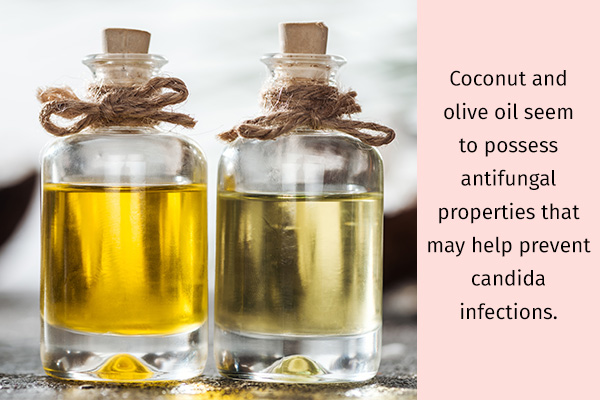
Research has focused its attention on the effects of the kind of fats you eat on the colonization of yeast within your gut. Two edible oils that seem to possess antifungal properties that may help prevent candida infections are coconut and olive oil, largely due to their fatty acid profile.
It is suggested that the lauric acid in coconut oil can help alter the functioning of yeast cells to prevent them from overgrowing and forming a fungal biofilm that causes an infection. These findings are primarily based on animal studies and need to be replicated in larger human trials, but researchers are hopeful that upping the dietary intake of coconut oil will benefit humans in the same way. (1)
Furthermore, consuming both coconut oil and olive oil may even be useful in controlling the growth of yeasts that are resistant to the standard antifungal drug fluconazole. (5)(6)
3. Probiotics
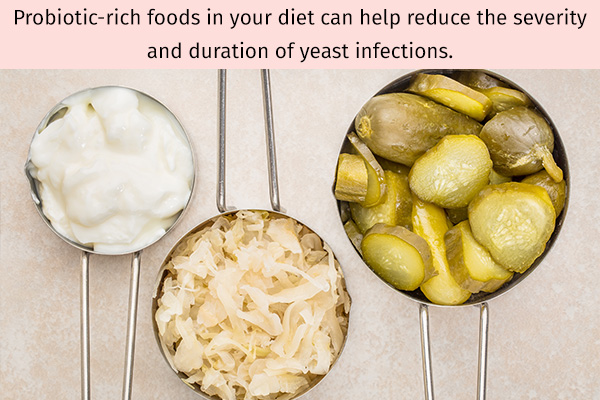
With the rise of drug-resistant fungi, more sustainable preventive measures are required today, and probiotics are a step in that direction.
Fermented foods such as pickles, kimchi, sauerkraut, buttermilk, yogurt, cheese, kefir, and sour cream are some of the best dietary sources of probiotics. Studies show that including these probiotic-rich foods in your diet can help reduce the severity and duration of yeast infections.
The mechanism behind this is simple: probiotics are beneficial bacteria that help keep the harmful microbes under control to maintain a healthy gut flora. By that logic, they can help inhibit the fungal overgrowth within your gut that paves the way for yeast infections. (7) In fact, probiotics have been proposed as an effective, easy-to-use, and well-tolerated alternative treatment for candida infections. (8)
The anti-candida activities of probiotics such as lactobacillus (9) and acidophilus on oral candidiasis have been attributed to the facts that probiotics regulate the pH of the environment, produce hydrogen peroxide, (10) release high amounts of lactic acid, and curb the growth of infective biofilms. (11)
Research also favors using prebiotics along with probiotics as the former enhance the activity of the latter to provide greater protection against yeast infections. (12)
4. Garlic
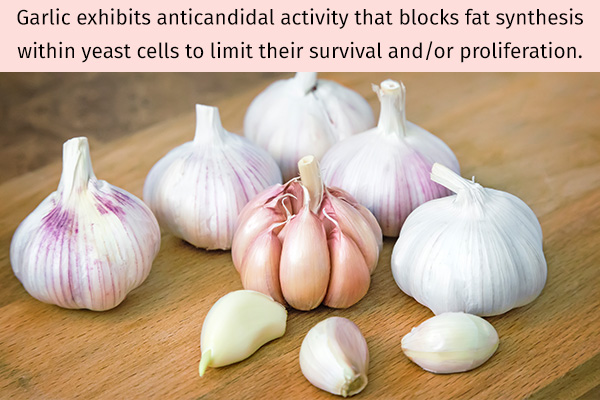
As mentioned above, C. albicans first attaches itself to a suitable surface and then multiplies rapidly to form a biofilm, which becomes the source of a yeast infection.
But how do these pathogens multiply? Like every other living thing on this planet, fungi are also made of cells. These cells produce macromolecules, such as proteins, important fats, and nucleic acids, within themselves to sustain the organism and allow it to reproduce. So, anything that blocks the production of these important substances will retard the growth of the organism before it can take the form of an infection. (13)
Garlic seems to do just that. Studies suggest that garlic exhibits anticandidal activity that blocks fat synthesis within yeast cells to limit their survival and/or proliferation. These antifungal effects can mostly be traced back to allicin, the chief sulfur-containing chemical in garlic. (14)
Allicin is released when you cut raw garlic but is completely inactivated or destroyed by cooking. So, garlic is best eaten raw to get the most of its medicinal properties. You can chew 2–3 cloves of raw garlic every day, add them to your salads, or sprinkle them on other dishes. If the taste of raw garlic is too strong for you, chop it into tiny pieces and mix them in yogurt to make it more palatable.
Garlic can also be taken medicinally in powder or supplement form, but do consult your doctor before starting this remedy to determine its safety and the appropriate dosage for you.
5. Turmeric
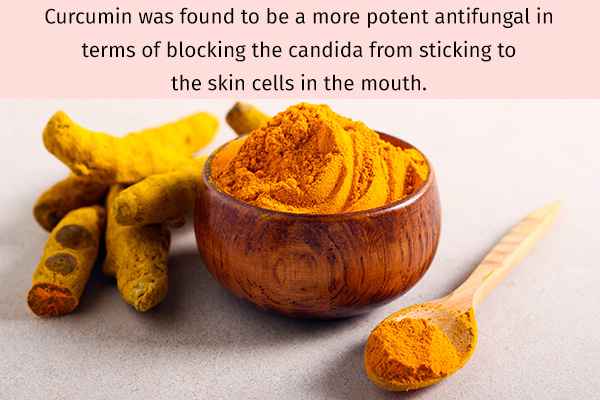
Turmeric (Curcuma longa) is a wonder herb, commonly used as a spice, and has been studied for its various medicinal benefits. One such benefit is its ability to inhibit pathogenic fungal overgrowth, which can be traced back to its principal bioactive compound called curcumin.
In a study conducted on patients with HIV suffering from oral thrush, curcumin was found to be a more potent antifungal than fluconazole in terms of blocking the candida from sticking to the skin cells in the mouth. This led to the conclusion that curcumin is a promising lead compound that can be put to therapeutic use in immunocompromised patients. (15)
Yeast cells, like all living systems, need enzymes to survive and grow. Some of these enzymes are dependent on iron to function. It has been shown that curcumin can penetrate cells and lower the availability of iron, making it unavailable to the enzymes. This then restricts the growth of the fungi. (16)
Plus, the antifungal effect of curcumin against C. albicans was observed to get stronger with increasing dosage. (17) The easiest way to increase your intake of turmeric is by using it more to flavor your dishes. The good thing is this versatile spice goes well with a lot of different types of foods.
You can also make yourself a healing tonic in the form of turmeric milk and drink it every day until your condition improves. All you have to do is add 1 teaspoon of organic turmeric to a glass of milk, and then boil the mixture on low heat for about 10 minutes.
6. Onion

A number of studies have highlighted the antifungal properties of onion that might prove useful in the treatment of yeast infections. (18)
Onion extracts have been shown to inhibit the growth of various kinds of fungi, including C. albicans, due to their content of sulfur-containing compounds. You can get concentrated amounts of these compounds in the essential oils derived from onion, which are especially volatile against the infection-causing yeasts. (19)
Onion extracts target the outer cell covering of the fungi, leading to spillage of their inner components, ultimately resulting in cellular death. Plus, onions are also replete with various antioxidants, including vitamin C, vitamin B6, and potassium, which strengthen your immunity and help your body recover faster from an infection.
You eat onions raw, use them as a side dish, or put them in your salads and soups. The goal is to include this healthy ingredient in your daily diet.
7. Cinnamon
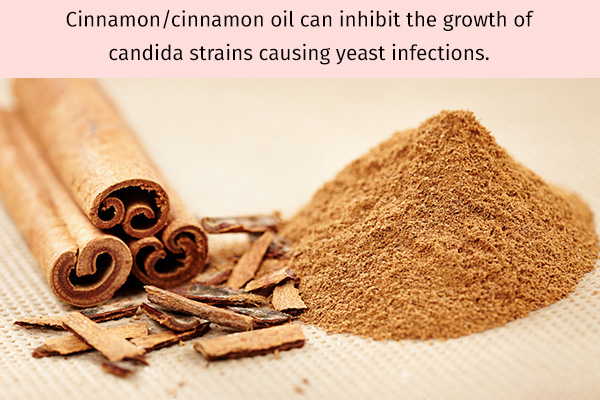
Cinnamon is credited with antimicrobial properties that can be traced back to an organic compound called cinnamaldehyde found in it. It is known to inhibit the growth of various pathogens, including bacteria such as Staphylococcus aureus and fungi such as yeast species (Candida lipolytica).
Cinnamaldehyde destroys the outer membrane of the fungal cells to leak its inner components, causing their death. (20) As a result, the fungus is unable to proliferate and form a biofilm that is needed to trigger an infection.
Experts have compared the antimicrobial activity of cinnamon to that of clove oil and have even suggested that it might work against candida strains that are resistant to the main antifungal drug fluconazole.
In fact, studies have been conducted to study the effectiveness of cinnamon/cinnamon oil in curbing the growth of these stubborn species in people with HIV diagnosed with oral candidiasis. The findings showed that this remedy did improve the condition of the patients to some degree, but more extensive studies are needed to corroborate these positive results. (21)
The best way to consume cinnamon is by adding it as a spice to your dishes. There are cinnamon supplements available as well, but you must consult your doctor before starting them.
8. Nonstarchy vegetables
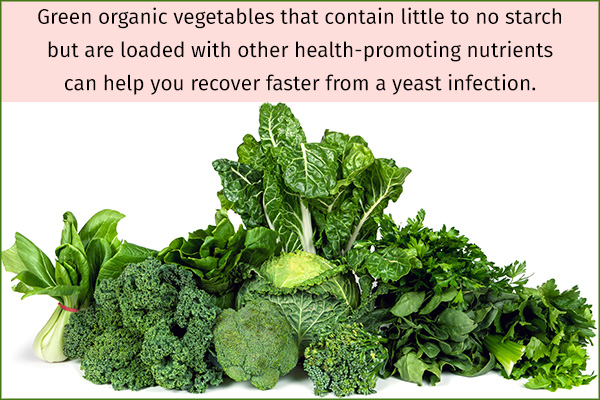
Green organic vegetables that contain little to no starch but are loaded with other health-promoting nutrients can help you recover faster from a yeast infection. Some of the most recommended ones are broccoli, cauliflower, spinach, lettuce, asparagus, celery, and parsley.
Yeast tends to thrive in acidic environments, but leafy veggies such as spinach, broccoli, and lettuce help deter that by making your body more alkaline. They also contain high amounts of magnesium and chlorophyll, which help remove toxins from your system. Plus, their rich reserve of iron and vitamins C and B help enhance your energy and immunity levels.
It is best to eat these vegetables raw, steamed, or lightly sautéed as the cooking process can deplete their inherent nutrient value. But there are some cruciferous vegetables such as cauliflower and broccoli that retain their nutrient value even after cooking.
The highlight of all these vegetables is they contain minimal sugar. Yeast cells feed on sugar or carbs to multiply rapidly and trigger an infection. Cutting off their source of sustenance will make it difficult for the fungus to survive or grow. Precisely for this reason, you are expected to eat less starchy vegetables such as potatoes, carrots, beets, and radishes.
The idea is to include these low-carb vegetables in an overall healthy and well-balanced diet. You can add them to your dishes, salads, or even juice them. Research suggests that drinking fermented vegetable juice made with celery, spinach, parsley, lettuce, broccoli, and lettuce might bolster the population of healthy gut bacteria. (22)
9. Green tea

C. albicans need to stick to one another and to the surfaces of the host to proliferate and form a biofilm, which eventually gives rise to an infection. It has been suggested that once an individual pathogen weaves a biofilm, it undergoes changes that make it strong enough to resist the action of antifungal drugs.
This is where green tea can help. It is rich in polyphenols, especially epigallocathechin-3-gallate, that have been shown to destroy about three-fourth of the yeast cell population making up the biofilm.
Yeast cells contain an enzyme called proteasome, which is responsible for eliminating their waste material. The green tea polyphenols impair these enzymes, causing poor waste management within the cells. This hampers the fungi’s ability to multiply and maintain itself, thus inhibiting biofilm formation and reducing infection risk. (23)(24)(25)
10. Oregano
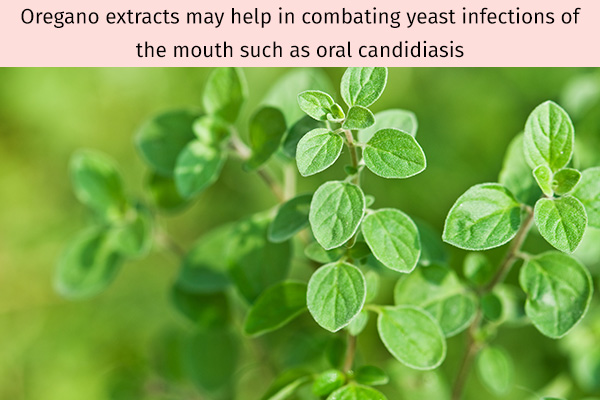
Oregano is an herb replete with active phytochemicals, most notably terpenoid phenols such as thymol and carvacrol, that exhibit considerable antifungal activity. (26)(27) These compounds block the growth of the fungi and prevent them from infecting the host by inhibiting their hyphal formation.
The antifungal effects of oregano have been found to be similar to those of drugs such as nystatin and amphotericin B. Furthermore, studies suggest that oregano extracts may help in combating yeast infections of the mouth such as oral candidiasis. (27)
So far, research on oregano as an antifungal agent has been very promising, but more large-scale and rigorous human trials are needed to establish its efficacy.
Foods to Avoid or Limit

The following foods can increase the risk, duration, or severity of yeast infections, so it’s best to avoid them while you are grappling with the condition.
1. Sugars
Excessive intake of carbs (which ultimately break down into sugars) and processed sugar has been linked with an increased incidence of yeast infections, especially in women. Increased sugar in your system helps create an environment inside the body that is favorable for the growth of yeast.
A few healthy dietary modifications can help bring down your sugar consumption considerably. Start by replacing refined grains with whole grains in your daily diet. While whole grains are not devoid of carbohydrates, they also contain a lot of dietary fiber, which makes you feel full quickly, thus reducing your overall intake.
Refined grains, on the other hand, are pure carbs as all their other nutrients are stripped away during processing. It goes without saying that you should avoid desserts, sweetened juices, and sauces and dressings that often contain hidden sugars.
2. Alcohol
Too much alcohol kills the healthy bacteria inside your body, disrupting the gut flora. Healthy bacteria help keep the infection-causing microbes under control, but this imbalance makes the environment more conducive to the growth of yeast.
3. Toxic metals
Some foods contain metals such as mercury, lead, arsenic, and cadmium, which can be harmful and even lethal if consumed in concentrated amounts. One of their toxic effects is an increased susceptibility to yeast infections. Thus, it is important to limit your intake of foods that contain such metals, for instance, mercury-containing fish.
4. Food additives
Certain foods contain chemicals such as aspartame (artificial sweetener) and MSG (monosodium glutamate) that can harm the body in different ways, including the destruction of the friendly intestinal flora.
The use of hormones and pesticides in food production also contributes to this destruction of the gut microbiome, compromising your overall immunity. The loss of healthy gut bacteria allows yeast cells to overgrow and trigger an infection easily.
Final Word
Contrary to popular belief, fungal infections are not a reflection of personal hygiene. Dirty living conditions or eating habits can make you more vulnerable to this illness, but they are not the sole causes behind it.
In fact, even those who are extremely particular about cleanliness can easily contract yeast infections due to a variety of reasons, an important one being poor food choices that lead to weakened immunity.
So, the importance of healthy eating cannot be stressed enough when it comes to preventing and managing yeast infections. However, the foods mentioned above can’t do much on their own unless combined with an overall healthy diet and lifestyle. Staying active, managing stress, and maintaining a healthy weight will also help your body fight the infection better.
- Was this article helpful?
- YES, THANKS!NOT REALLY


